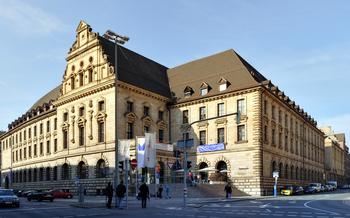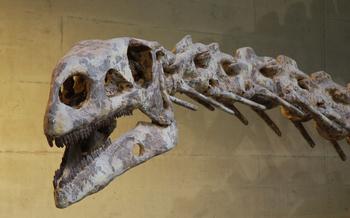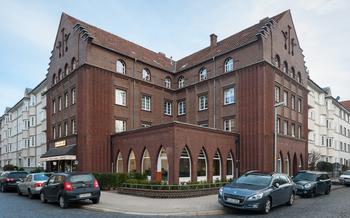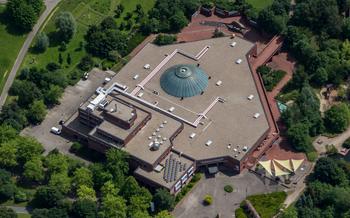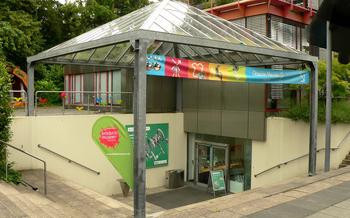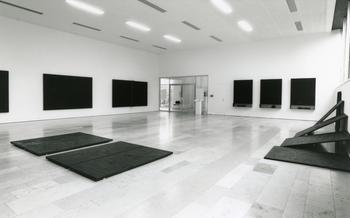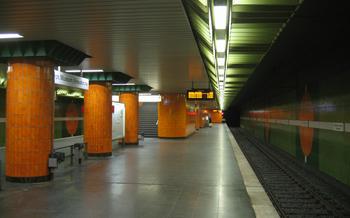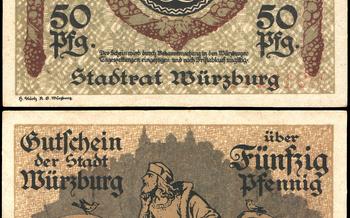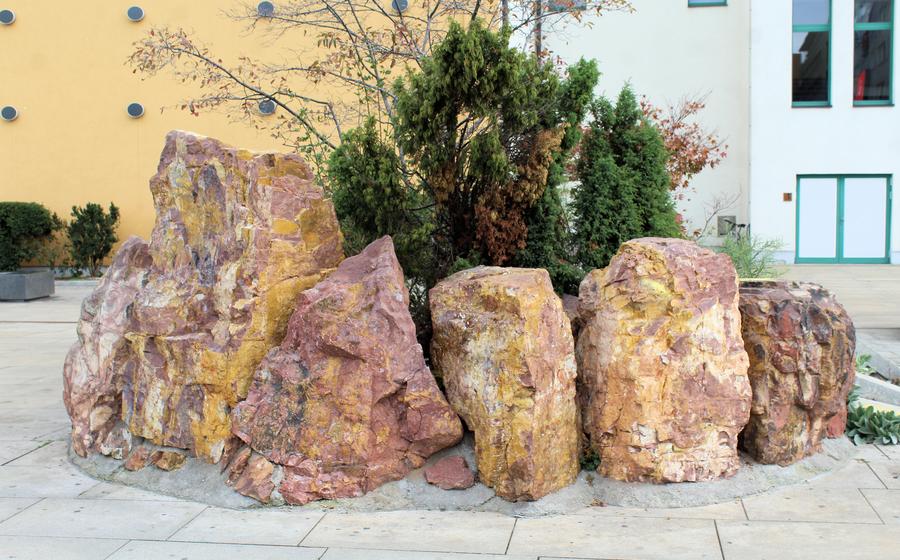
Chemnitz Museum of Natural History
- The Chemnitz Museum of Natural History: A Journey Through Time and Nature
- Exhibits and Collections: Unveiling the Wonders of the Natural World
- Educational Programs and Workshops: Inspiring the Next Generation of Scientists
- Research and Conservation: Preserving Biodiversity and Advancing Knowledge
- Temporary Exhibitions: Exploring Current Issues and Trends
- Architecture and Design: A Modern Showcase for Natural History
- Museum Shop and Café: Enhancing the Visitor Experience
- Accessibility and Inclusivity: Ensuring Equal Access for All
- Community Engagement and Outreach: Fostering a Connection with Nature
- Behind-the-Scenes Tours: Uncovering the Hidden Treasures
- Seasonal Events and Activities: Celebrating Nature Throughout the Year
- Museum's Role in Sustainable Development: Promoting Environmental Responsibility
- Online Resources and Virtual Tours: Extending the Museum's Reach
- Admission and Hours of Operation: Planning Your Visit
- Insider Tip: Discovering Hidden Gems in the Museum
The Chemnitz Museum of Natural History: A Journey Through Time and Nature
Nestled in the heart of Chemnitz, the Museum of Natural History stands as a testament to the wonders of the natural world. Its history dates back to 1874 when a group of passionate naturalists laid the foundation for a collection that would eventually become one of the most significant natural history museums in Germany. Driven by a mission to promote scientific knowledge and foster a deep appreciation for the environment, the museum has evolved into a vibrant center for education, research, and conservation.
The Chemnitz Museum of Natural History plays a pivotal role in the cultural fabric of Chemnitz, attracting visitors from across the region and beyond. Its diverse exhibitions, educational programs, and community outreach initiatives make it an essential destination for anyone seeking to explore and understand the intricate tapestry of the natural world. On a regional and national level, the museum is recognized for its exceptional contributions to scientific research, environmental education, and the preservation of natural heritage.
Exhibits and Collections: Unveiling the Wonders of the Natural World
The Chemnitz Museum of Natural History boasts an impressive array of exhibits that showcase the wonders of the natural world. Visitors can embark on a captivating journey through time and discover the diversity of life that has inhabited our planet. The exhibits are meticulously organized into thematic sections, allowing visitors to explore specific topics in depth.
Among the highlights of the collection are the remarkable dinosaur fossils, which offer a glimpse into the prehistoric era. The museum houses a stunning collection of bones and skeletons, providing valuable insights into the anatomy, behavior, and evolution of these magnificent creatures. The mineral collection is another treasure trove, showcasing a dazzling array of minerals and gemstones from around the world. Visitors can marvel at the intricate formations, vibrant colors, and unique properties of these natural wonders.
The museum's exhibits are not merely static displays; they are designed to engage and educate visitors of all ages. Interactive displays and multimedia presentations bring the exhibits to life, allowing visitors to explore the natural world in a hands-on and immersive manner. Educational programs and workshops are also offered throughout the year, providing opportunities for visitors to learn more about specific topics and gain hands-on experience with scientific research.
The Chemnitz Museum of Natural History is a true testament to the wonders of the natural world. Its exhibits and collections offer a fascinating glimpse into the diversity of life and the processes that shape our planet. Whether you are a seasoned naturalist or simply curious about the world around you, this museum is sure to captivate and inspire.
Educational Programs and Workshops: Inspiring the Next Generation of Scientists
The Chemnitz Museum of Natural History offers a diverse range of educational programs and workshops designed to ignite a passion for science and nature in young minds. School groups and families can embark on guided tours led by experienced educators who bring the exhibits to life with engaging stories and hands-on activities. Children have the opportunity to explore the wonders of the natural world through interactive displays, specimen handling, and scientific experiments.
One of the highlights of the museum's educational offerings is the "Fossil Detectives" workshop, where participants become paleontologists for a day. They learn about the techniques used to uncover and study fossils, and then embark on a fossil hunt in the museum's collection. The workshop culminates in the creation of their own fossil casts, which they can take home as a lasting memento of their experience.
The museum also hosts regular workshops and activities during school holidays and breaks. These events often have a specific theme, such as "Dinosaurs," "Insects," or "Rocks and Minerals." Children can participate in themed crafts, games, and demonstrations, all while learning about the natural world in a fun and interactive way.
The museum's educational programs and workshops are not only enjoyable but also effective in fostering a love of science and nature in young people. Many former participants have gone on to pursue careers in science, conservation, or environmental education, inspired by their experiences at the Chemnitz Museum of Natural History.
Research and Conservation: Preserving Biodiversity and Advancing Knowledge
The Chemnitz Museum of Natural History is not just a showcase for exhibits; it is also a hub for scientific research and conservation efforts. The museum's staff is actively engaged in a variety of research projects aimed at preserving biodiversity and advancing our understanding of the natural world. These projects encompass a wide range of topics, from studying the behavior and ecology of local wildlife to conducting paleontological excavations and analyzing the effects of climate change on ecosystems.
The museum collaborates closely with other institutions and organizations, both within Germany and internationally, to share knowledge and resources and contribute to a global effort to protect and preserve our planet's biodiversity. Through partnerships with universities, research centers, and conservation organizations, the museum is able to expand its reach and impact, supporting important research initiatives and contributing to the development of conservation strategies.
The museum's research activities are not limited to the laboratory or the field; they also extend to the public. Through workshops, lectures, and guided tours, the museum's staff shares their findings with visitors, fostering a greater understanding of the importance of biodiversity and the need for conservation. This outreach helps to raise awareness and inspire the next generation of scientists and conservationists.
The Chemnitz Museum of Natural History plays a vital role in advancing scientific knowledge and promoting conservation efforts. Through its research and collaboration, the museum contributes to a better understanding of the natural world and helps to protect and preserve our planet's biodiversity for future generations.
Temporary Exhibitions: Exploring Current Issues and Trends
In addition to its permanent exhibits, the Chemnitz Museum of Natural History regularly hosts temporary exhibitions that explore current issues and trends in the field of natural history. These exhibitions often feature cutting-edge research, innovative technologies, and thought-provoking themes. Through these exhibitions, the museum aims to engage visitors with contemporary topics, foster dialogue, and promote critical thinking about the natural world.
Temporary exhibitions at the Chemnitz Museum of Natural History are typically organized in collaboration with renowned scientists, artists, and institutions. This collaboration ensures that the exhibitions are both scientifically accurate and visually appealing. The museum also works closely with educational institutions to develop educational programs and activities that complement the temporary exhibitions, making them a valuable resource for students and educators.
The frequency of temporary exhibitions varies depending on the availability of funding and resources. However, the museum strives to present at least one major temporary exhibition each year. Past exhibitions have covered a wide range of topics, including climate change, biodiversity loss, the evolution of life, and the latest discoveries in paleontology.
Temporary exhibitions at the Chemnitz Museum of Natural History are a great way to stay up-to-date on the latest developments in the field of natural history. They offer visitors the opportunity to learn about current research, engage with contemporary issues, and gain new perspectives on the natural world. These exhibitions are also an important part of the museum's mission to inspire curiosity, promote understanding, and foster a sense of wonder and appreciation for the natural world.
Architecture and Design: A Modern Showcase for Natural History
The Chemnitz Museum of Natural History is housed in a striking modern building that reflects the museum's commitment to innovation and contemporary design. The building's unique architectural features include a curved glass façade that allows for ample natural light to flood the interior spaces, creating a bright and welcoming atmosphere. The use of sustainable materials, such as wood and glass, further emphasizes the museum's commitment to environmental responsibility.
Inside, the museum's layout is designed to be accessible and visitor-friendly, with wide corridors, clear signage, and interactive displays. The exhibits are organized thematically, allowing visitors to easily navigate the museum and explore their areas of interest. The use of interactive multimedia displays, touchscreens, and hands-on activities enhances the visitor experience, making learning about natural history fun and engaging for people of all ages.
The museum's architecture has been widely recognized for its excellence, receiving numerous awards and accolades. In 2015, the museum was awarded the German Museum Architecture Prize for its innovative design and successful integration of modern architecture with the museum's educational mission. The building's unique curved façade has become a landmark in Chemnitz, symbolizing the city's commitment to culture, science, and innovation.
Museum Shop and Café: Enhancing the Visitor Experience
The Chemnitz Museum of Natural History offers a well-stocked museum shop where visitors can purchase a variety of souvenirs and educational materials to remember their visit. The shop carries a wide selection of books, postcards, and gifts related to natural history, including guides to local flora and fauna, children's books about dinosaurs and animals, and unique souvenirs such as fossils, minerals, and replicas of museum specimens.
The museum also has an on-site café that provides refreshments and light meals for visitors. The café offers a range of options, including sandwiches, salads, soups, and cakes, as well as hot and cold drinks. Visitors can enjoy their food and drinks in the café's cozy seating area or take them outside to enjoy in the museum's courtyard or nearby park.
The museum shop and café contribute to the overall visitor experience by providing a place for visitors to relax, learn, and find unique gifts and souvenirs. They also generate revenue that helps to support the museum's educational programs and conservation efforts.
Accessibility and Inclusivity: Ensuring Equal Access for All
The Chemnitz Museum of Natural History is committed to creating an inclusive environment where everyone can enjoy and learn from its exhibits. The museum's physical spaces and programs are designed to be accessible to visitors of all abilities. Wheelchair ramps and elevators provide easy access to all floors of the museum, and Braille signage and audio guides assist visitors with visual impairments. The museum also offers programs and activities specifically tailored for visitors with disabilities, such as sensory-friendly tours and workshops. By removing barriers and creating a welcoming environment, the museum ensures that everyone has the opportunity to explore the wonders of the natural world.
Community Engagement and Outreach: Fostering a Connection with Nature
The Chemnitz Museum of Natural History goes beyond its role as a repository of knowledge and specimens by actively engaging with the local community and fostering a connection with nature. The museum recognizes that its impact extends beyond its walls, and it strives to create a sense of ownership and belonging among the people of Chemnitz.
Through partnerships with local schools and organizations, the museum brings the wonders of natural history to students and community members alike. Educational programs, workshops, and field trips introduce participants to the diversity of life on Earth, inspiring them to appreciate and protect the environment.
The museum also hosts community events and festivals that celebrate the natural world. These events provide opportunities for people to come together, learn about different cultures, and discover the beauty of the local ecosystem. By creating a platform for dialogue and exchange, the museum strengthens its ties with the community and encourages a sense of environmental stewardship.
Whether through educational programs, community events, or outreach initiatives, the Chemnitz Museum of Natural History plays a vital role in fostering a connection between people and nature. It empowers individuals to become advocates for the environment and contributes to building a more sustainable and harmonious relationship with the natural world.
Behind-the-Scenes Tours: Uncovering the Hidden Treasures
For those seeking an exclusive glimpse into the inner workings of the Chemnitz Museum of Natural History, guided behind-the-scenes tours offer a unique opportunity to explore the hidden treasures of the museum. These tours venture beyond the public exhibits, taking visitors through the museum's storerooms, laboratories, and research facilities. Led by experienced curators and researchers, these tours provide an insider's perspective on the museum's vast collection, the ongoing research projects, and the conservation efforts undertaken by the museum's dedicated team.
Participants in these exclusive tours have the chance to witness the meticulous work involved in preserving and studying the museum's specimens. They can examine rare and fragile artifacts up close, learn about the latest conservation techniques, and gain insights into the fascinating world of scientific research. The tours also offer an opportunity for visitors to interact directly with the museum's experts, asking questions and gaining a deeper understanding of the museum's mission and the importance of its work.
Advance booking is required for these behind-the-scenes tours due to their limited availability. The tours are suitable for individuals, families, and small groups with a genuine interest in natural history and scientific research. They provide a truly unforgettable experience, offering a unique perspective on the museum's collection and the dedication of its staff to preserving and sharing the wonders of the natural world.
Seasonal Events and Activities: Celebrating Nature Throughout the Year
The Chemnitz Museum of Natural History brings nature to life with a variety of seasonal events and activities designed to engage and educate visitors of all ages. During the holidays and school breaks, the museum transforms into a festive wonderland, hosting special events that immerse visitors in the wonders of the natural world. Themed workshops, lectures, and demonstrations provide opportunities for hands-on learning and exploration. Outdoor activities and nature walks allow visitors to experience the beauty of the natural surroundings firsthand. These seasonal events and activities create memorable experiences that foster a love and appreciation for the environment.
Museum's Role in Sustainable Development: Promoting Environmental Responsibility
The Chemnitz Museum of Natural History recognizes its responsibility in promoting environmental responsibility and sustainable practices. Through its exhibitions, educational programs, and community outreach initiatives, the museum actively contributes to raising awareness about environmental issues and encouraging visitors to adopt sustainable behaviors.
Exhibitions such as "Climate Change: Our Planet in Peril" explore the causes and consequences of climate change, showcasing the impacts on ecosystems, biodiversity, and human societies. Interactive displays allow visitors to understand the complex interactions between human activities and the natural world, inspiring them to make informed choices to reduce their environmental footprint.
The museum collaborates with environmental organizations to develop educational programs and workshops focused on sustainability. These programs address topics such as waste reduction, energy efficiency, and biodiversity conservation. School groups and families participate in hands-on activities that teach them about sustainable practices and empower them to make a positive impact on their communities.
Furthermore, the museum leads by example in implementing sustainable practices within its operations. It utilizes renewable energy sources, reduces waste through recycling and composting initiatives, and promotes sustainable transportation options for staff and visitors. By embracing sustainability in all aspects of its operations, the museum demonstrates its commitment to environmental responsibility.
Online Resources and Virtual Tours: Extending the Museum's Reach
In addition to its physical exhibits, the Chemnitz Museum of Natural History offers a range of online resources and virtual tours to extend its reach and engage with a global audience. These digital offerings provide an immersive and interactive experience for those who cannot visit the museum in person or who wish to delve deeper into its collections and research.
Through the museum's website, visitors can access a wealth of digital content, including high-resolution images of specimens, detailed descriptions of exhibits, and educational articles written by experts in various fields of natural history. Virtual tours allow users to navigate through the museum's galleries and explore its collections from the comfort of their own homes or classrooms. These tours are accompanied by audio commentary, providing visitors with insights into the stories behind the exhibits and the museum's research.
The museum also maintains an active presence on social media platforms, sharing engaging content such as behind-the-scenes videos, quizzes, and educational posts. Through social media, the museum connects with a diverse audience, promotes its events and exhibitions, and fosters a sense of community among nature enthusiasts.
These online resources and virtual tours play a crucial role in expanding the museum's reach and impact, making its collections and knowledge accessible to a global audience. They also serve as valuable educational tools for students, researchers, and anyone interested in exploring the wonders of the natural world.
Admission and Hours of Operation: Planning Your Visit
Planning a visit to the Chemnitz Museum of Natural History is easy and convenient. The museum offers affordable ticket prices, with discounts available for families and groups. Advance ticket purchase and reservations are recommended to avoid queues during peak hours.
The museum's operating hours are typically from 10 am to 5 pm, Tuesday through Sunday. However, it is advisable to check the museum's website or call ahead to confirm hours of operation, especially during holidays or special events.
To make the most of your visit, consider arriving early to avoid crowds and have ample time to explore the exhibits. Allow at least two to three hours to fully immerse yourself in the museum's offerings.
If you have limited time, prioritize the exhibits that most interest you. The museum's website provides a detailed overview of the exhibits, allowing you to plan your visit accordingly.
Remember to wear comfortable shoes as you will be doing a lot of walking. Also, consider bringing a camera to capture your favorite exhibits and moments.
With its rich collection, engaging exhibits, and educational programs, the Chemnitz Museum of Natural History is a must-visit destination for anyone interested in exploring the wonders of the natural world.
Insider Tip: Discovering Hidden Gems in the Museum
Beyond the main exhibits, the Chemnitz Museum of Natural History holds a treasure trove of hidden gems waiting to be discovered by curious visitors. One secret spot is the museum's archive, which houses a vast collection of historical documents, photographs, and research papers. Here, you can delve into the history of the museum and its collections, uncovering the stories behind the exhibits and the people who brought them to life.
Another hidden gem is the museum's research library, which contains a wealth of scientific literature, journals, and books on various aspects of natural history. Whether you're a student, a researcher, or simply someone with a thirst for knowledge, you'll find a wealth of information here to satisfy your curiosity.
Don't forget to keep an eye out for unique artifacts and specimens that may be tucked away in corners or displayed in smaller exhibits. These hidden treasures often tell fascinating stories about the natural world and the museum's history. Take your time to explore every nook and cranny, and you're sure to uncover some hidden gems that will make your visit even more memorable.

